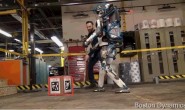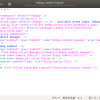一、第一个ArUco的视觉应用
首先介绍第一个视觉应用的Demo,这个应用场景比较简单,下面具体介绍:
1. 应用场景
主线程:通过摄像头检测环境中的视觉标志,看到ID为100的标志后在图像中圈出标志,在标志上绘制坐标系,得到视觉标志相对于相机坐标系的位置和姿态参数; 子线程:将得到的视觉标志进一步转换成需要的数据类型并发送给机器人。
2. 编程环境
Ubuntu14.04(安装有OpenCV以及ArUco)
3. 编译工具
Cmake
4. 源码下载地址
https://github.com/Zhanggx0102/Aruco_Blog_Demo.git
5. 源码处理
下载完成后重新编译即可。
cd Aruco_Blog_Demo-master
rm -r build/
mkdir build
cd build
cmake ..
make
二、源码解读
源码中已经做了比较详细的注释,这里主要讲解程序框架。 程序流程图如下所示:  程序流程图 执行后的效果如下图所示:
程序流程图 执行后的效果如下图所示:  下面是源码截取的两个主要的函数。
下面是源码截取的两个主要的函数。
/*******************************************************************************************************************
main function
********************************************************************************************************************/
int main(int argc,char **argv)
{
int thread_return;
pthread_t Message_Send_Thread_ID;
//init thread lock
pthread_mutex_init(&IK_Solver_Lock, NULL);
//creat new thread
thread_return = pthread_create(&Message_Send_Thread_ID,NULL,Thread_Func_Message_Send,NULL);
//import the camera param (CameraMatrix)
float camera_matrix_array[9] = { 1.0078520005023535e+003, 0., 6.3950000000000000e+002,
0.0, 1.0078520005023535e+003, 3.5950000000000000e+002,
0.0, 0.0, 1.0 };
cv::Mat Camera_Matrix(3,3,CV_32FC1);
InitMat(Camera_Matrix,camera_matrix_array);
cout << "Camera_Matrix = " << endl << "" << Camera_Matrix << endl ;
//import the camera param (Distorsion)
float Distorsion_array[5] = {-4.9694653328469340e-002, 2.3886698343464000e-001, 0., 0.,-2.1783942538569392e-001};
cv::Mat Distorsion_M(1,5,CV_32FC1);
InitMat(Distorsion_M,Distorsion_array);
cout << "Distorsion_M = " << endl << "" << Distorsion_M << endl ;
CameraParameters LogiC170Param;
//LogiC170Param.readFromXMLFile("LogitchC170_Param.yml");
LogiC170Param.CameraMatrix = Camera_Matrix.clone();
LogiC170Param.Distorsion = Distorsion_M.clone();
LogiC170Param.CamSize.width = 1280;
LogiC170Param.CamSize.height = 720;
float MarkerSize = 0.04;
int Marker_ID;
MarkerDetector MDetector;
MDetector.setThresholdParams(7, 7);
MDetector.setThresholdParamRange(2, 0);
CvDrawingUtils MDraw;
//read the input image
VideoCapture cap(0); // open the default camera
if(!cap.isOpened()) // check if we succeeded
return -1;
cv::Mat frame;
cv::Mat Rvec;//rotational vector
CvMat Rvec_Matrix;//temp matrix
CvMat R_Matrix;//rotational matrixs
cv::Mat Tvec;//translation vector
cap>>frame;//get first frame
//LogiC170Param.resize(frame.size());
printf("%f, %f\n",cap.get(CV_CAP_PROP_FRAME_WIDTH),cap.get(CV_CAP_PROP_FRAME_HEIGHT));
cap.set(CV_CAP_PROP_FRAME_WIDTH, 1280);
cap.set(CV_CAP_PROP_FRAME_HEIGHT, 720);
//cap.set(CV_CAP_PROP_FPS, 10);
printf("%f, %f\n",cap.get(CV_CAP_PROP_FRAME_WIDTH),cap.get(CV_CAP_PROP_FRAME_HEIGHT));
while(1)
{
//get current frame
cap>>frame;
//Ok, let's detect
vector< Marker > Markers=MDetector.detect(frame, LogiC170Param, MarkerSize);
//printf("marker count:%d \n",(int)(Markers.size()));
//for each marker, estimate its ID and if it is 100 draw info and its boundaries in the image
for (unsigned int j=0;j<Markers.size();j++)
{
//marker ID test
Marker_ID = Markers[j].id;
printf("Marker ID = %d \n",Marker_ID);
if(Marker_ID == 100)
{
//cout<<Markers[j]<<endl;
Markers[j].draw(frame,Scalar(0,0,255),2);
Markers[j].calculateExtrinsics(MarkerSize, LogiC170Param, false);
//calculate rotational vector
Rvec = Markers[j].Rvec;
cout << "Rvec = " << endl << "" << Rvec << endl ;
//calculate transformation vector
Tvec = Markers[j].Tvec;
cout << "Tvec = " << endl << "" << Tvec << endl ;
//lock to update global variables: Rotat_Vec_Arr[3] Rotat_M[9] Trans_M[3]
pthread_mutex_lock(&IK_Solver_Lock);
//save rotational vector to float array
for (int r = 0; r < Rvec.rows; r++)
{
for (int c = 0; c < Rvec.cols; c++)
{
//cout<< Rvec.at<float>(r,c)<<endl;
Rotat_Vec_Arr[r] = Rvec.at<float>(r,c);
}
}
printf("Rotat_Vec_Arr[3] = [%f, %f, %f] \n",Rotat_Vec_Arr[0],Rotat_Vec_Arr[1],Rotat_Vec_Arr[2]);
//save array data to CvMat and convert rotational vector to rotational matrix
cvInitMatHeader(&Rvec_Matrix,1,3,CV_32FC1,Rotat_Vec_Arr,CV_AUTOSTEP);//init Rvec_Matrix
cvInitMatHeader(&R_Matrix,3,3,CV_32FC1,Rotat_M,CV_AUTOSTEP);//init R_Matrix and Rotat_M
cvRodrigues2(&Rvec_Matrix, &R_Matrix,0);
printf("Rotat_M = \n[%f, %f, %f, \n %f, %f, %f, \n %f, %f, %f] \n",Rotat_M[0],Rotat_M[1],Rotat_M[2],Rotat_M[3],Rotat_M[4],Rotat_M[5],Rotat_M[6],Rotat_M[7],Rotat_M[8]);
//save transformation vector to float array
for (int r = 0; r < Tvec.rows; r++)
{
for (int c = 0; c < Tvec.cols; c++)
{
Trans_M[r] = Tvec.at<float>(r,c);
}
}
printf("Trans_M[3] = [%f, %f, %f] \n",Trans_M[0],Trans_M[1],Trans_M[2]);
//unlock
pthread_mutex_unlock(&IK_Solver_Lock);
// draw a 3d cube in each marker if there is 3d info
if (LogiC170Param.isValid() && MarkerSize != -1)
{
MDraw.draw3dAxis(frame,LogiC170Param,Rvec,Tvec,0.04);
}
}
}
//*/
cv::waitKey(150);//wait for key to be pressed
cv::imshow("Frame",frame);
}
//wait for the IK solver thread close and recover resources
pthread_join(Message_Send_Thread_ID,NULL);
pthread_mutex_destroy(&IK_Solver_Lock); //destroy the thread lock
return 0
}
/**********************************************************
function: new thread to send messages
input: void
return :null
***********************************************************/
void * Thread_Func_Message_Send(void *arg)
{
printf("IK solver thread is running!\n");
//original pose and position
float P_original[4];
float N_original[4];
float O_original[4];
float A_original[4];
//final pose and position
float P[3];
float N[3];
float O[3];
float A[3];
P_original[3] = 1;
N_original[3] = 0;
O_original[3] = 0;
A_original[3] = 0;
while (1)
{
//get the spacial pose
pthread_mutex_lock(&IK_Solver_Lock);
//memcpy(P_original, Trans_M, sizeof(Trans_M));
for(int i=0;i<3;i++)
{
P_original[i] = Trans_M[i];
N_original[i] = Rotat_M[3*i];
O_original[i] = Rotat_M[3*i+1];
A_original[i] = Rotat_M[3*i+2];
}
pthread_mutex_unlock(&IK_Solver_Lock);
//debug printf
///*
printf("N_original[4] = [%f, %f, %f, %f] \n",N_original[0],N_original[1],N_original[2],N_original[3]);
printf("O_original[4] = [%f, %f, %f, %f] \n",O_original[0],O_original[1],O_original[2],O_original[3]);
printf("A_original[4] = [%f, %f, %f, %f] \n",A_original[0],A_original[1],A_original[2],A_original[3]);
printf("P_original[4] = [%f, %f, %f, %f] \n",P_original[0],P_original[1],P_original[2],P_original[3]);
//*/
printf("I send the message to robot here! \n");
/*
add message send function here!
*/<br>
//uodate every 5 s
sleep(5);
}
//kill the message send thread
pthread_exit(0);
}
<– 本篇完–>




